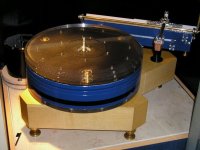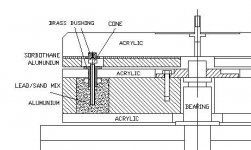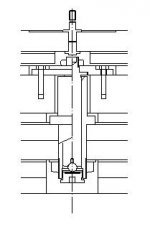Looks like you cut up the kitchen table to make that massive plinth! Very nice.
Now for the all important question ...
... how does it sound?
Enjoy,
Bob
Now for the all important question ...
... how does it sound?
Enjoy,
Bob
Hi,
Congrats, Michael....Beautiful job.
Constrained Layer Damping.
Cheers,😉
Congrats, Michael....Beautiful job.
What's a CLD platter?
Constrained Layer Damping.
Cheers,😉
Re: Re: One more DIY TT is born
Constraint Layer Damping is extremely efficient method to absorb vibration by placing a viscous layer (sorbotane in my case)between two rigid ones (acrylic and aluminum on upper plate).
Of course, for unsuspended TT the whole assembly rigidity is a must (my upper acrylic plate is directrly coupled to subplatter by means of three bronze cones).
Note, the central pin is decoupled from bearing for sake of bearing-induced vibrations isolation.
Well, in terms of isolation from external and stylus-induced vibration it is close to perfection (IMHO), it means deep black background without a shadow of HF roll-off.
Teres motor/controller does extremely good job: piano sounds are rock stable, no traces of wow.
As for tonearm/cart synergy, I feel my high comliance Grado Statement Sonata is not completely happy with Ladegaard's lateral high mass: occasionally a low frequency resonance-like artefacts (call is distortions) may be heard on certain records (complicated orchestral music). I think I shall give Denon 103 a try (looks like a general consensus here) - stay tuned...
rif said:
What's a CLD platter?
Constraint Layer Damping is extremely efficient method to absorb vibration by placing a viscous layer (sorbotane in my case)between two rigid ones (acrylic and aluminum on upper plate).
Of course, for unsuspended TT the whole assembly rigidity is a must (my upper acrylic plate is directrly coupled to subplatter by means of three bronze cones).
Note, the central pin is decoupled from bearing for sake of bearing-induced vibrations isolation.
BobM said:
Now for the all important question ...
... how does it sound?
Well, in terms of isolation from external and stylus-induced vibration it is close to perfection (IMHO), it means deep black background without a shadow of HF roll-off.
Teres motor/controller does extremely good job: piano sounds are rock stable, no traces of wow.
As for tonearm/cart synergy, I feel my high comliance Grado Statement Sonata is not completely happy with Ladegaard's lateral high mass: occasionally a low frequency resonance-like artefacts (call is distortions) may be heard on certain records (complicated orchestral music). I think I shall give Denon 103 a try (looks like a general consensus here) - stay tuned...
Attachments
bearing
Conventional type bearing: bronze housing, SS spindle, SS ball, delrin thrust plate. Lower end of the housing is closed by threaded plug with O-ring sealing, I just tried to keep manufacturing simplier. The bearing is placed well within the platter, in order to keep platter CofG closer to the bearing surface geometrical center.
Aircraft grade hydraulic oil of low viscousity is used, since the viscous friction is substantional, due to very tigh fit and large bearing surface area.
Conventional type bearing: bronze housing, SS spindle, SS ball, delrin thrust plate. Lower end of the housing is closed by threaded plug with O-ring sealing, I just tried to keep manufacturing simplier. The bearing is placed well within the platter, in order to keep platter CofG closer to the bearing surface geometrical center.
Aircraft grade hydraulic oil of low viscousity is used, since the viscous friction is substantional, due to very tigh fit and large bearing surface area.
Attachments
Any standard or heavy (thick) 12" record. Plenty of space is left for peripetial ring clamp, which i hope to implement one day.What's the biggest LP your tonearm can play?
Two aquarium pumps connected in parallel feed the arm through 1.5 m long surge tank/filter, stuffed with syntetic wool.what are are you using for an air supply with your arm ?
Look here:Please tell us more about the arm
http://www.diyaudio.com/forums/showthread.php?s=&threadid=9084&perpage=10&pagenumber=1
Correct. Well, hum is a complicated problem, but I don't think wire shielding is a major factor, as long as you do not have powerful EMI sources around. At least I feel no difference, connecting the arm outer AL tube to ground. I prefer to keep wire capacitance as low as posible.Is the wire from the cartridge to output connectors just twisted pairs?
- Status
- Not open for further replies.
- Home
- Source & Line
- Analogue Source
- One more DIY TT is born



